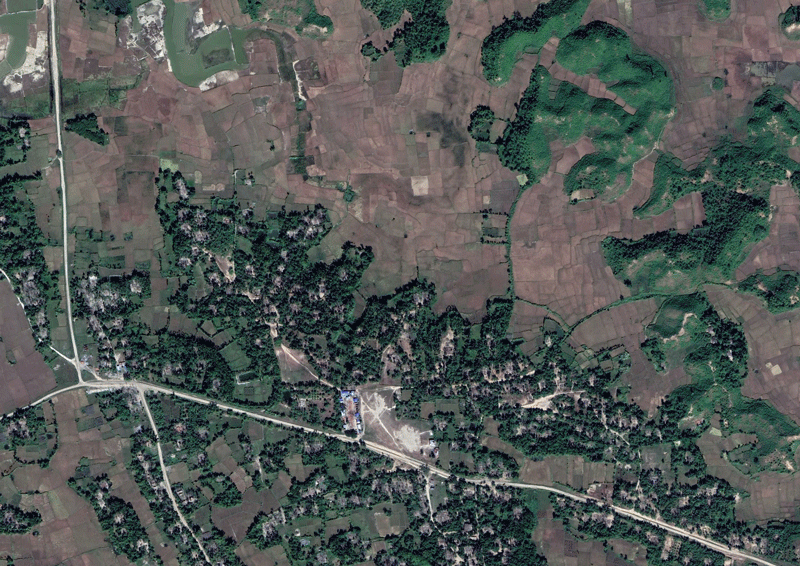
Image: Maxar via Google.
In June 2019, a report by the Association of Southeast Asian Nations on Rakhine State, Myanmar, was leaked to the media. In it, ASEAN outlines a process for the return of 500,000 Rohingya refugees to Myanmar over a period of six years. As of April 2019, more than 910,000 Rohingya were living in refugee camps in Cox’s Bazar in Bangladesh.
The leaked report, which one major media outlet said gave ‘a glowing assessment of Myanmar’s efforts to entice Rohingya refugees back from Bangladesh’, attracted widespread criticism from civil society and human rights groups.
In fairness to ASEAN’s Emergency Response and Assessment Team, which put together the report, it was only a preliminary assessment; the team had a limited mandate and was deployed in Rakhine State for just 10 days. But this backlash highlights one of the biggest problems with what is occurring in Rakhine State—multilateral agencies, policymakers, civil society groups and the public have very little information on which to base their assessments and decision-making.
The situation has been exacerbated by the internet shutdown that the Myanmar government ordered telecommunications companies to impose on 22 June in parts of Rakhine State and neighbouring Chin State. UN Special Rapporteur Yanghee Lee said in early July that the ‘information blackout is imperilling villagers, further obstructing the humanitarian response and shielding the military operations from scrutiny’. The internet remains shut down.
New research by ASPI’s International Cyber Policy Centre seeks to fill in some of these information gaps by adding to the evidence base available to policymakers and relevant stakeholders about conditions in northern Rakhine State, and in Rakhine State more broadly. It also aims to contribute to informed discussions about the best path towards a safe, dignified and sustainable future for the Rohingya refugees.
Our research combined open-source data with the collection and analysis of new satellite imagery to assess the level of preparation in Rakhine State to receive returning refugees. We mapped the current status of 392 Rohingya settlements which were identified by UNOSAT data as damaged or destroyed during the 2017 crisis. We also mapped potential repatriation camps and military bases constructed on the sites of former Rohingya settlements.
The findings of this research are set out in an interactive report.
We found that more than 320 settlements show no sign of reconstruction and at least 40% of affected settlements have been razed. In addition to settlements affected in the 2017 crisis, we identified at least 58 other settlements in which there was fresh or ongoing demolition in 2018. Satellite imagery also shows that demolition has occurred in some settlements in 2019.
We also found that at least 45 camps have been constructed or enlarged (some of these camps are believed to be for internally displaced people, returning refugees or both) and identified six suspected military facilities built or expanded on the sites of former Rohingya settlements.
According to the ASEAN report, the Myanmar government’s plan is that returning refugees will first be taken to ‘reception centres’ where they will undergo a registration process involving the gathering of biometric details. They will then be sent to what is called a ‘transit centre’ at Hla Pho Khaung (see the satellite image above, which shows the facility’s construction between 1 December 2017 and 12 December 2018).
The Hla Pho Khaung transit centre can accommodate 25,000 people in ‘temporary shelters’. There’s additional capacity to accommodate returning refugees in ‘container-type’ shelters.
Returning refugees may stay in the transit centre for a maximum of 30 days, after which they’ll have three options:
- If their original houses are still habitable, they can return to them immediately.
- They can move to relocation sites provided by the government.
- They can participate in cash-for-work programs to rebuild their houses in identified areas.
The extent of burning during the 2017 crisis and the continued destruction of Rohingya settlements during 2018 and 2019 suggest that few Rohingya are likely to be able to return to their original houses. Our findings also raise serious questions about the willingness of the Myanmar government to facilitate the repatriation process.
Further, two laws, the Vacant, Fallow and Virgin Lands Management Law and the Natural Disaster Management Law, effectively expand government ownership and management of the land on which Rohingya settlements were located, raising further doubt that refugees will be able to return to their original homes or land.
It seems most returning refugees will be settled in ‘relocation sites’, either in government-built shelters or in houses built through the cash-for-work programs. Refugees may own their houses, but the land is now owned by the Myanmar government.
New construction at proposed relocation sites, such as Kyain Chaung, strongly resembles a camp rather than the villages that were there before the crackdown (see the image below, which shows the changes at the Kyain Chaung site between December 2017 and May 2019).

Image: Maxar via Google/PlanetLabs.
Satellite evidence also confirms the highly securitised nature of northern Rakhine State. The Border Guard Police—a paramilitary group associated with the military—maintains a network of security posts throughout northern Rakhine State.
Fortified security posts have been built in some of the remaining Rohingya villages. And some new buildings constructed for the Taung Pyo Letwe reception centre are in a prison-like configuration, including housing areas fully surrounded by fencing and six watchtowers overlooking the 10,000-square-metre facility. This securitisation raises concerns that freedom of movement and access to services may be restricted.
Our research does not support assertions that conditions are in place to support a dignified, safe and sustainable return of Rohingya people. Satellite analysis shows minimal preparation for a return of half a million refugees. The preparations that are being made raise significant concerns about the conditions under which returning Rohingya refugees would be expected to live.

